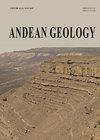阿根廷纽昆安达科洛矿区索菲亚-朱莉娅-瓦伦西亚脉系的地质、热液蚀变和矿物学
IF 1.2
4区 地球科学
Q3 GEOLOGY
引用次数: 0
摘要
Sofía-Julia-Valencia矿脉系统位于阿根廷中西部的Andacolo矿区,由ENE-WSW走向的走滑断层承载,这是上白垩纪-古近系影响石炭系至侏罗系岩石的正断层复活的结果。这些矿脉包含22900 Oz的黄金总资源,AuEq为5.5-6.7 g/t。地质测绘和在该地区蚀变和矿化的英安岩脉中获得的锆石U-Pb年龄为71±1Ma,使矿化事件与Naunauco安地质带岩浆作用(上白垩纪-古近纪)和阿根廷西南部安第斯山脉的白垩纪-古第三纪成矿带相关联。矿体由多个矿脉和细脉组成,从最古老到最年轻,对应于:(1)稀缺的早期石英+黄铁矿+辉钼矿+贫铁闪锌矿细脉,(2)石英+绿帘石+方解石±钠长石(磷灰石+金红石+钛石+含轻稀土元素的磷酸盐)与石英+黑云母、绿帘石(阳起石)+绿泥石+方解石相关,含黄铁矿+磁黄铁矿±黄铜矿±(富铁闪锌矿)、绿泥石脉。这些矿脉被(3)石英+绢云母±碳酸盐(绿泥石)形成的多金属矿脉和细脉切割并重新打开,其中富含铁金的闪锌矿+富含银的方铅矿+黄铜矿+黄铁矿,天然金±毒砂±(磁黄铁矿、斑铜矿、银铜矿)。黄铁矿(4)和(5)碳酸盐+弹壳状黄铁矿细脉切割了所有以前的细脉。多级碳酸盐生成角砾岩,并切割先前的矿脉和细脉。石英呈粒状、梳状结构,一些方解石呈片状结构。四种热液蚀变类型影响了脉主岩:(1)早期钾质蚀变斑块;(2) 广泛的含浸染状硫化物的丙基蚀变;(3) 后千枚岩蚀变与前千枚岩重叠;和(4)晚表生代的改变。矿脉(1和2)中的闪锌矿和绿泥石成分及其矿物组合表明,它们是由最初的碱性流体(如长石稳定)形成的,具有中等的硫和氧逸度以及中温温度条件(约400-240°C),然后演变成较低的硫(如磁黄铁矿稳定)和氧逸性,温度本文章由计算机程序翻译,如有差异,请以英文原文为准。
Geología, alteración hidrotermal y mineralogía del sistema de vetas Sofía-Julia-Valencia, distrito minero Andacollo, Neuquén, Argentina
The Sofía-Julia-Valencia vein system, located in the Andacollo mining district in central west Argentina, is hosted by ENE-WSW oriented strike-slip faults which are the result of reactivation of normal faults affecting Carboniferous to Jurassic rocks during Upper Cretaceous-Paleogene. These veins contain a total resource of 22,900 Oz of gold with 5.5-6.7 g/t AuEq. Geologic mapping and a U-Pb age of 71±1Ma in zircon, obtained in an altered and mineralized dacitic dyke of the district, allowed to associate the mineralizing event to the Naunauco Andesitic belt magmatism (Upper Cretaceous-Paleogene) and to the Cretaceous-Paleogene Metallogenic Belt of the Andes in southwestern Argentina. The ore bodies are made up of multiple veins and veinlets that, from oldest to youngest, correspond to: (1) scarce early quartz+pyrite+molybdenite+iron poor-sphalerite veinlets, (2) quartz+epidote+calcite±albite (apatite+rutile+titanite+light rare earth elements bearing phosphates) associated with quartz+biotite, epidote (actinolite)+chlorite+calcite, with pyrite+pyrrhotite±chalcopyrite±(iron rich-sphalerite), marcasite veins. These veins are cut and reopened by (3) polymetallic veins and veinlets formed by quartz+sericite±carbonates (chlorite), with iron-gold rich sphalerite+silver rich-galena+chalcopyrite+pyrite, native gold±arsenopyrite±(pyrrhotite, bornite, argentite). Pyrite (4) and (5) carbonate+framboidal pyrite veinlets cuts all the previous ones. Multistage carbonate generation brecciate and cut previous veins and veinlets. Quartz shows granular, comb textures and some calcites developed platy textures. Four hydrothermal alteration types affected the veins host rock: (1) patches of early potassic alteration; (2) widespread propylitic alteration with disseminated sulfides; (3) later phyllic alteration overlapped to the previous ones; and (4) late supergene alteration. The sphalerite and chlorite composition in the veins (1 and 2) along with their mineral assamblages indicates they were formed by initially alkaline fluids (e.g., feldspar stable) with intermediate sulfur and oxygen fugacity and mesothermal temperature conditions (~400-240 °C), that evolved to conditions of lower sulfur (e.g., pyrrhotite stable) and oxygen fugacity, temperature
求助全文
通过发布文献求助,成功后即可免费获取论文全文。
去求助
来源期刊

Andean Geology
地学-地质学
CiteScore
3.90
自引率
0.00%
发文量
17
审稿时长
>12 weeks
期刊介绍:
This journal publishes original and review articles on geology and related sciences, in Spanish or English, in three issues a year (January, May and September). Articles or notes on major topics of broad interest in Earth Sciences dealing with the geology of South and Central America and Antarctica, and particularly of the Andes, are welcomed.
The journal is interested in publishing thematic sets of papers and accepts articles dealing with systematic Paleontology only if their main focus is the chronostratigraphical, paleoecological and/or paleogeographical importance of the taxa described therein.
 求助内容:
求助内容: 应助结果提醒方式:
应助结果提醒方式:


